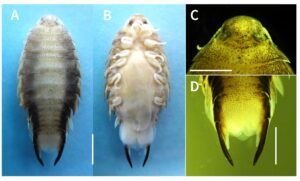Abstract / Introduction / Summary:

Japanese sardine, Sardinops melanostictus (Temminck and Schlegel, 1846), infected with Nerocila phaiopleura Bleeker, 1857, were collected in coastal waters of the western North Pacific Ocean near Cape Inubo, Chiba Prefecture, central Japan, in June 2024. Of 17 infected fish examined, 16 (94.1%) and one (5.9%) fish harbored one and two isopods, respectively. The isopods were ovigerous females and firmly attached to the host’s posterior body surface near the lateral line above the anal fin. The fish examined were damaged by the isopod infection, and the skin damages at attachment sites were classified into two types, slight wounds and severe wounds. Small scars formed by insertion of the dactyli of the isopod were found in the slight wounds. In contrast, fish muscles were exposed in the severe wounds, which are inferred to be caused by the isopod feeding on the host tissues. The fish were all young (115–170 mm body length) and the impact of the isopod infection on the young fish is discussed.
